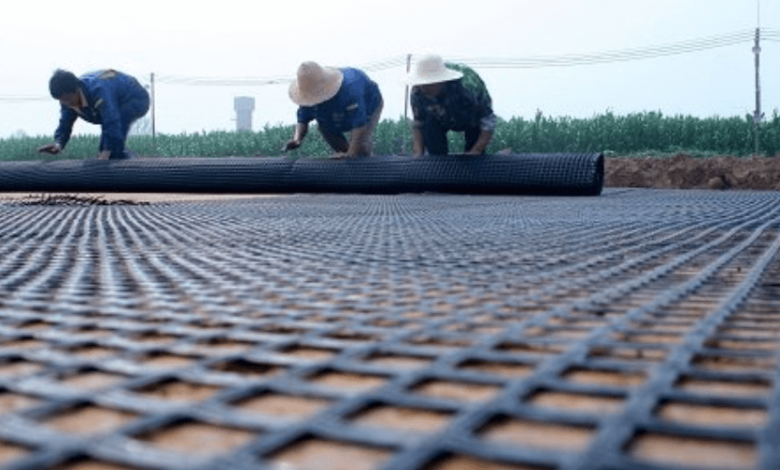What Is a Geogrid? A Modern Solution for Ground Stabilization

In the world of civil engineering, ensuring the stability of roads, walls, and other structures built on or with soil is critical. One modern technology that has revolutionized how engineers tackle unstable ground is the geogrid. But for those new to the concept, the question may arise: what is a geogrid and why is it essential in today’s construction practices?
Let’s explore the definition, types, functions, applications, and benefits of geogrids in a comprehensive and easy-to-understand way.
Defining Geogrid
To answer the question what is a geogrid, one must first understand that it is a synthetic material used to reinforce soil and other base materials. Manufactured from high-strength polymers like polypropylene, polyester, or polyethylene, a geogrid is formed into a grid-like pattern with open spaces (apertures) that allow aggregate or soil to interlock.
Geogrids are typically installed within soil layers to improve load distribution and ground performance. They serve as a mechanical stabilizer that holds soil in place, strengthens foundations, and prevents movement, especially in areas where the ground is weak or uneven.
See also: Construction Hoists Lifts: Essential Tools for Modern Vertical Transportation on Job Sites
Types of Geogrids
There are three main types of geogrids used in engineering, each serving a unique purpose depending on structural needs.
1. Uniaxial Geogrid
These are designed to be strong in one direction—lengthwise. They are most commonly used to reinforce retaining walls, slopes, and embankments where soil pressure comes from a single direction.
2. Biaxial Geogrid
Biaxial geogrids have equal strength in both directions, making them ideal for subgrade stabilization beneath roads, parking lots, and airports. They help distribute loads evenly in both length and width.
3. Triaxial Geogrid
This newer design offers multi-directional strength through triangular patterns. Triaxial geogrids are especially effective in high-stress areas, improving the stiffness of the base and enhancing durability.
How a Geogrid Works
Now that we’ve defined what is a geogrid it’s time to understand how it functions. When placed between layers of soil or aggregates, the open structure of the geogrid allows the fill material to lock into the grid spaces. This interlocking mechanism:
- Prevents lateral movement of particles
- Improves load transfer
- Increases bearing capacity
- Minimizes settlement
By creating a stable matrix, the geogrid effectively transforms soft or shifting soil into a firm foundation suitable for construction.
Key Benefits
The use of geogrids in construction and landscaping provides several distinct advantages:
Increased Load-Bearing Capacity
Geogrids help spread loads across a wider area, reducing stress on the underlying soil and enhancing the strength of the surface.
Reduced Material Requirements
Since geogrids increase the efficiency of soil and aggregates, fewer materials may be needed, leading to cost savings and faster project completion.
Longer Lifespan of Infrastructure
By preventing erosion, subsidence, and deformation, geogrids extend the life of roads, walls, and other structures.
Eco-Friendly Solution
Using geogrids enables builders to use recycled or local fill material, lowering the environmental impact of transportation and excavation.
Versatile Application
Geogrids can be used in urban infrastructure, rural roads, landscaping, mining, railways, and even agricultural projects.
Common Applications
Understanding what is a geogrid becomes more practical when we examine its real-world uses.
Road and Pavement Construction
Geogrids are often used beneath asphalt roads, gravel paths, and concrete slabs to provide subgrade reinforcement, reduce cracking, and improve surface longevity.
Retaining Walls
When building retaining walls to support vertical or near-vertical grade changes, geogrids are used to strengthen the soil and allow taller, thinner, or more cost-efficient structures.
Slopes and Embankments
On hillsides or sloped terrains, geogrids prevent soil erosion and offer structural integrity to landscaping or roadway projects.
Installation Process
Installing a geogrid is relatively straightforward, though precision is key to performance. Below is a simplified step-by-step process:
- Site Preparation
Clear vegetation, debris, and loosened soil. Compact the subgrade as needed. - Geogrid Placement
Unroll the geogrid over the prepared surface, cutting it to length. Ensure that grids are aligned and overlap per engineering specifications. - Securing the Grid
Use pins, stakes, or weights to keep the geogrid flat and taut. - Fill Placement
Spread the chosen fill material over the grid in layers. Take care not to damage the grid during the process.
Factors to Consider in Geogrid Design
Engineers take several factors into account before choosing and installing a geogrid:
- Soil Type: Sandy or granular soils generally interlock better than clay-rich soils.
- Traffic Load: Higher loads require stronger or thicker geogrids.
- Environmental Conditions: Temperature, moisture, and chemical exposure affect performance.
Comparison With Other Geosynthetics
Geogrids are often compared to geotextiles, another form of geosynthetic used for separation and filtration. However, the two serve different roles:
| Feature | Geogrid | Geotextile |
| Function | Soil reinforcement | Filtration, separation, erosion control |
| Structure | Grid-like with large apertures | Fabric-like with small pores |
| Load Bearing | High | Low to moderate |
| Primary Use | Roads, walls, slopes | Drainage, erosion control |
Thus, while both materials are valuable, geogrids are preferred for structural reinforcement tasks.
Innovations and the Future of Geogrids
As construction technology advances, so do geogrids. Newer versions incorporate smart sensors to detect stress or moisture changes, enabling predictive maintenance. Additionally, researchers are developing biodegradable geogrids and products made from recycled plastic waste, supporting greener building practices.
With increasing demand for sustainable infrastructure and resilient design, geogrids are expected to play a bigger role in future construction projects worldwide.
Final Thoughts
To summarize, if you’re wondering what is a geogrid, it is a powerful engineering tool designed to stabilize and reinforce ground materials. Whether under a busy highway or behind a decorative garden wall, geogrids serve as the unseen backbone of modern infrastructure.
Lightweight yet strong, easy to install yet durable, geogrids solve a wide range of soil-related challenges while saving money and protecting the environment. For engineers, builders, and property developers, understanding and using geogrids is no longer optional—it’s a necessity for quality and sustainability in construction.





